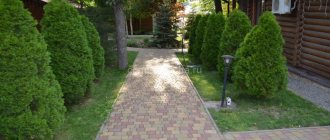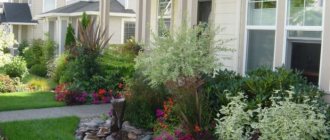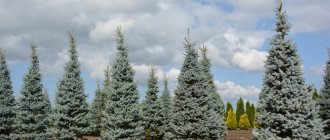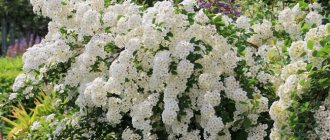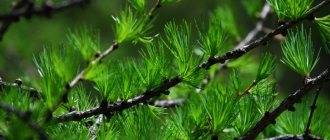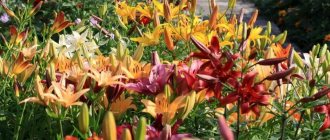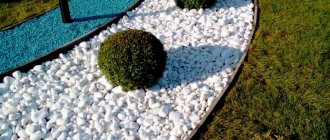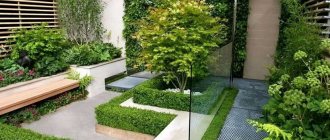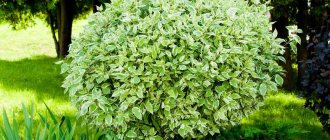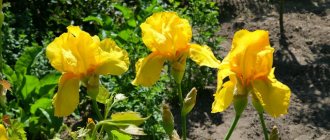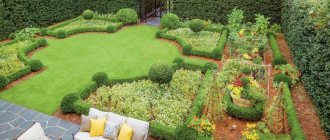Thujas can give any garden plot an attractive and elegant appearance. They are planted solo, in groups, along alleys, in rock gardens, mixboards, and on alpine hills. There is a huge variety of types and varieties of thuja. Therefore, they will harmoniously fit into absolutely any landscape design and become its main decoration.
In this article we will look at the advantages and disadvantages of planting conifers on the site, what types and varieties of thuja exist, how to plant and care for them correctly, and much other useful information.
Features of thuja: pros and cons
Arborvitae in landscape design are not only the main decoration of the yard, but they fill the area with a pleasant, unobtrusive aroma of pine needles and purify the air. They can be grown in sunny meadows, in the shade, on hills. The main thing is that there are no drafts and water does not stagnate. And this plant will withstand all other unfavorable factors.
As for the advantages of planting thuja in landscape design, they include:
- ease of care;
- ability to grow in any terrain (in shade, partial shade, well-lit areas);
- undemanding to the composition of the soil;
- long lifespan;
- resistance to negative factors;
- aesthetic and noble appearance;
- good compatibility with other plants and shrubs;
- maintaining decorativeness throughout the year.
But this plant has no disadvantages. The only thing is that some gardeners consider this tree to be useless, since in addition to being decorative, it does not bring any benefit. But one beautiful type of thuja in the design of the site is already enough.
Description and characteristics
The variety of species and varieties of thuja is impressive. There are specimens that grow up to 15 meters in height over the years. There are also dwarf plants, the height of which does not exceed 30-50 cm. The crown of the trees is dense, the bark easily peels off from the trunk. Thuja is easily propagated by seeds and cuttings, which take root well in the summer.
Young seedlings have soft needles and a light green color. Over the years, the needles become coarser, become scaly, and darken. The cones on the trees are small and the seeds are flat. Representatives of different species live from 10 to 100 years or more. Some centenarians grow well in one place for up to 150 years.
Types and varieties of coniferous plants
There are two types of thuja, which in turn are divided into numerous varieties:
- Western.
- Eastern.
The most popular varieties of the Western species are:
- Danniku . A low tree up to half a meter in height and up to 1 m in diameter. Completely easy to care for. Grows on suspended and light loamy soils. Planted as a single plant, it looks beautiful among flowers. It grows slowly, therefore, the overall composition of the flower garden does not change its appearance for a long time. Thuja looks especially attractive near the house;
- Globos . Its height is about 1 m. It grows on fertile soils and likes moderate watering. Fits harmoniously into any landscape designs;
- Hoseri . A small tree, 40 cm in diameter. Well suited for small areas, planted in stone gardens and rock gardens.
Among the oriental species, the following varieties are worth highlighting:
- Justinka . Its height reaches 1 m, the crown is columnar, bright green. Looks good in small compositions;
- Columna . Externally similar to cypress. The height reaches 8 m, and in diameter it spreads over 1 m. Suitable for creating a Mediterranean style in the country;
- Wagnery . A tall tree, the height of which reaches 4 m. It tolerates frost well, but does not like snowfall. Its branches break off under the weight of the snow. It is recommended to plant in open areas.
PYRAMIDAL AND CONICAL CROWN SHAPE
Pyramidal or conical arborvitae are often vigorous growers and therefore ideal for creating neat, dramatic living walls.
Such elegant fences protect the area from strong winds and hide your garden from the prying eyes of neighbors. In a landscape composition, they are planted in the background, allowing beautiful flowering shrubs to come forward. (thuja occidentalis Smaragd) - Tall tree with emerald green needles, dense, conical crown.
The color of the needles does not change throughout the year and does not fade with insufficient lighting. In the middle zone, this variety is extremely popular not only for its attractive appearance, but also for its unconditional resistance to unstable climatic conditions.
It grows slowly - only 15-25 cm in height per year and in adulthood will reach 6 meters. Used as a hedge, to decorate stylistic gardens and create delightful compositions.
(thuja occidentalis Brabant) is an evergreen coniferous plant characterized by its impressive size and rapid growth.
Can grow up to 8 meters in height. Thuja Brabant has a cylindrical crown, and its branches very often fall to the ground. The needles are bright green in color with delightful golden tips that shimmer favorably in the sun.
To be highly decorative, the tree needs pruning and crown shaping. Looks impressive as a living wall for zoning a site.
(Thuja occ. Aurea Nana) is a low-growing representative of conifers. It has an ovoid habit in youth, and over the years it acquires a conical shape. The shoots are yellowish, dense.
The needles are thick, scaly, green with a golden tint, and remain on the tree all year round. The advantage of this variety: the “correct” arrangement of branches, bright color and small compact size.
Very young plants require shelter for the winter with spruce branches; adults have fairly strong frost resistance. An ideal solution for small, rocky gardens and alpine slides.
(thuja occidentalis Wagneri) is a tree with an ovoid or conical-ovate crown, small in stature, up to 3.5 m tall.
The crown is dense, directed upward, of a light green hue, which in the sun becomes silvery-metallic. Thuja Wagneri prefers fertile soils and a sunny location. Overwinters without shelter while retaining decorative needles.
For planting, it is recommended to choose open areas with sufficient light, but protected from strong winds. Used for compositions, lawn decoration and ideal as a hedge.
(Thuja occidentalis Columna) is the best variety for hedges that will divide your site into zones or hide from prying eyes.
Thuja Columna grows up to approximately 6 meters in height. The shoots are horizontal, short, slightly curved towards the ends. The apex of the habit is obtuse. The needles are bright green in color, small and scale-like, with a characteristic shine.
The variety is valued for its fast growth and high resistance to bad weather. Tolerates mild drought and frost, is unpretentious to growing conditions and is easy to care for. Needs crown formation and spring pruning.
(Thuja occidentalis Malonyana) - is a columnar variety of thuja with extremely unusual twisting shoots.
Narrow, upright, fast-growing form. The color is deep, rich green. Dense needles.
Unlike other varieties, Thuja Maloniana is a tall, slender tree that grows up to 10 meters or more and has a crown diameter of up to 3 m.
The nuances of the compatibility of thuja with other crops in a summer cottage
To create a beautiful landscape with thujas, you should know what they combine harmoniously with. These plants are planted one at a time in cases where we are talking about a tall specimen. And small trees should be placed on the site in small groups.
When planting thujas next to other plants, attention is paid to ensuring that both the first and second ones have the right soil composition. Along with them, low-growing mountain pines feel good in partial shade. And in a sunny meadow, black pines can become their companions.
You can also plant the following plants and shrubs next to the thujas:
- spirea;
- barberry;
- hybrid weigela;
- roses;
- magnolia;
- Potentilla
Attention: thujas do not like proximity to larch.
These plants look beautiful near children's playgrounds. Unlike their relatives, Christmas trees, they are completely safe for children, since their needles are soft. In addition, they release phytoncides that purify the air.
Landing
How to plant thuja? To do this, you need a place that should not be exposed to prolonged sunlight. Ultraviolet rays can dehydrate trees. Thuja needs deep and moist soil - choose turf soil; It is advisable to add sand and peat additives too.
If a group of trees is planted, then a certain separation between seedlings is required - 1-5 meters, to be more precise - a single-row hedge of thujas will take 1 meter, a double-row - 2 meters, and so on. Keep in mind that trees grow both in length and width. 60-80 cm is the most suitable depth for planting.
It is most favorable to plant thuja in spring, but it is not prohibited to do this in other seasons - under the right conditions, if the gardener knows how to plant thuja.
What are the criteria for choosing thuja for the garden?
Having decided to plant a noble thuja on your site, before purchasing a seedling you should decide:
- what size and volume will the plant be? It depends on what plantings it will be used for;
- where to plant ephedra: in the shade or in the sun. In principle, almost all varieties feel good both in the sun and in the shade;
- what color will its needles be? And it can be: emerald, gray, blue, brown, yellow. Some varieties change the color of their needles depending on the time of year.
When choosing the seedling itself, attention is paid to:
- rich color of needles and young growths . To do this, it is recommended to lightly press down the branch with your hand; if the needles instantly regain their shape and color, you can buy them;
- root system . It must be well developed. If the roots of a tree are hidden behind a lump of earth, it should be chipped. If we are talking about selling a seedling with an open root system, then its dimensions must correspond to the diameter of the crown. The color of the roots should be white-pink. If the roots are soft and brown, then the process of rotting has begun in them. Such a tree should be discarded immediately;
- smooth bark without cracks . Here it is important to pay attention to the pot in which the tree is planted. If there are stains of mold in it, then the seedling grew in poor conditions and is unlikely to please you with active growth;
- seedling age . It is advisable that he reach 4-5 years old, or even better - 8-9 years old. The plant must be grafted, have a good closed root system, and be treated against diseases and pests. Then the newly acquired plant will quickly go through the acclimatization process and take root well in its new location.
The main problems when growing coniferous trees
Caring for Thuja also includes pest and disease control. Fungal diseases cause the most trouble. For example, Fusarium, Cytosporosis. They affect shoots and needles of crops. To combat such diseases, Bordeaux mixture and Kartotsid are used. The treatment will be long-term, it is systematically repeated every 2 weeks. The end of therapy occurs only at the moment of complete recovery of the conifer.
Among the pests, the most dangerous are false scale insects or aphids. They can cause the needles to turn yellow and fall off. To eliminate such insects, it is better to use the drugs Rogor, Decis, Karbofos. The processing procedure begins before the buds open. The control method of treatment will be preventive spraying of trees with Actellik or Chlorophos. This procedure is performed at the end of June. The frequency of spraying is 2 times with an interval of 14 days.
This video talks about another Thuja pest - the Thuja pine beetle and how to deal with it
Where to plant ephedra on the site
Many owners of suburban areas are interested in the question: how to beautifully plant thuja on the site. This can be done in different ways. Place them in mixborders, plant them along the entire perimeter of the site, plant them in rock gardens and rock gardens. In other words, thuja looks beautiful in any garden design.
But the main thing is to choose the right place for active and proper growth of the tree. Depending on the variety, either a well-lit area or partial shade is selected. As for the soil, this plant is unpretentious to it, but most of all it loves loam. Therefore, when planting, it is recommended to mix fine river sand, peat and humus into the soil.
You cannot plant thuja in places where water often stagnates. This will lead to rotting of its root system and the death of the tree. The plant should also be protected from drafts and strong winds. The north-eastern side of the yard is selected for them.
Important : when planting thuja in a well-lit sunny meadow, it is worth considering that direct sunlight on the needles can cause burns on it.
Winter care
Frost-resistant and heat-loving conifers require attention in winter. It is better to immediately plant heat-loving conifers in large pots and move them to a cool room for the winter. Frost-resistant species can tolerate low temperatures, but it is better to cover them for the winter. Thuja grows well in Siberia and other northern regions if you provide it with proper care.
Important!
It is prohibited to apply nitrogen fertilizing to conifers before winter. Nitrogen stimulates plant growth, but in winter this is not necessary and can lead to freezing.
Tall seedlings can be wrapped in craft paper. In this case, the branches need to be pressed against the trunk. You can secure the paper with a rope. To shelter small coniferous trees from the Siberian frost, special bags or even cut plastic bottles are suitable. To protect young trees from the sun, frost, wind, and snow, you can install frames around them that can be easily stretched with fabric.
Rules for planting and caring for thujas
You can plant thuja in different ways. This is done using seeds, cuttings, and dividing the bush. The longest and most difficult process is growing a plant from seeds. Here you need to be able to collect and germinate them correctly. But growing a plant from a cutting is not particularly difficult. The main thing is to correctly cut off a side shoot from an adult tree, choose a suitable substrate for it, and wait until the cutting takes root.
Attention : plants that are 2-3 years old are planted in open ground. When it comes to buying a tree from a nursery, preference is given to 9-year-old plants.
The process of planting conifers is quite simple, and boils down to the following steps:
- Digging a hole for the plant. Its depth and diameter directly depend on the selected variety. Some varieties require a hole depth of up to 50 cm, others need to make a hole 1 m deep. As for the diameter, it is made no more than 60 cm.
- Next, pegs up to 2 m high are driven into the corners of the dug hole. They are necessary in order to securely fix the young plant after planting.
- Before planting the needles in the hole (two weeks before), the hole is filled to the top with fertile soil substrate.
- After two weeks, a hole is made in it, according to the size of the root system of the tree.
- The plant is placed in a hole and covered with earth, and then lightly trampled down.
- Next, the tree is tied to driven stakes and watered.
Attention: when planting thuja in the country, it is watered at the rate of 30 liters of water per tree.
After planting, the plant needs care. Despite the fact that this plant is completely unpretentious and you don’t need to spend a lot of free time on it, it needs:
- regular watering . It is held once a week. If there is a drought outside, it is better to water the thuja twice a week. One tree requires about 20 liters of water. If the summer is rainy, watering is kept to a minimum. Since this plant does not like waterlogged soil;
- loosening the soil and mulching . After the snow melts, it is necessary to loosen the ground to a depth of 10 cm. After this, mulch with straw, sawdust, small pebbles or humus. Mulching will help retain moisture in the soil and prevent the growth of weeds;
- fertilizer _ It is done twice a year (in spring and autumn) with special complex fertilizers for coniferous trees;
- pruning _ This procedure is necessary in order to give the tree the correct and beautiful shape. Pruning is carried out twice a year. Young trees under 3 years old are not pruned;
- proper preparation for winter . This is only necessary for newly planted young trees. It is recommended to prune them in the fall, water them well, feed them, mulch them, and reliably protect them from frost.
Diseases and pests
In the spring, the color of the bark of some conifer specimens changes to brown. This is how a fungal infection manifests itself. First, the bark turns yellow, then the lesion affects tissues located deeper. Over time, the branches die off. To eliminate the disease, the plant is sprayed in spring or summer with a solution of the drug “Fundazol” at a concentration of 3%. Before processing, all infected parts are cut off and burned.
Young plants develop rust from a lack of nutrients, too hot weather or high humidity. To improve the health of trees, they are sprayed with a solution of the drug “HOM”, prepared at the rate of 40 g of substance per 10 liters of water. Damaged areas are first removed.
With Schutte fungal disease, the needles acquire a darker shade and then fall off. The disease develops due to a deficiency of nutrients in the soil and poor care. To improve the health of the tree, it is sprayed with a solution of the drug “Topsin-M”, prepared from 10 liters of water and 15 g of the substance. Bordeaux mixture is also used instead.
Important!
The most dangerous disease of thuja is late blight. Infection develops from the roots. In a sick tree, the needles take on a gray tint, and plant tissues become loose. There is no cure for this disease. Therefore, infected specimens are immediately dug up and destroyed.
The main pests of thuja are:
- Thuja aphid feeding on plant sap. It causes yellowing and shedding of needles.
- Spider mites provoke the appearance of yellowish spots on the needles and their shedding. The pest is most active in dry weather.
- The moth gnaws tunnels in plant tissue. When infected with a parasite, the needles turn brown and fall off.
- False scale insects provoke wilting and drying out of the plant.
- The wireworm attacks the root system. The infected plant stops growing and dies over time.
- Bark beetles feed on bark and lay their eggs in it. After infection with the parasite, the plant gradually withers and dies.
To combat all insects, trees are sprayed with insecticide solutions. Treatments are carried out several times with an interval of 15 days. If there are few pests, use folk remedies: soap and tobacco solution, garlic water, ammonia.
Ideas for using thujas in the landscape design of a summer cottage
Thuja is an ornamental plant and does not perform any other functions. Therefore, they are planted only to create a beautiful landscape. Since it can be a tall tree or spreading shrub, conifers are planted on the site depending on the variety. Some species look beautiful as hedges, others are planted only solo or in groups. Dwarf rocks are ideal for rockeries, mixboards and rock gardens.
Attention : with the help of thujas, various decorative elements are beautifully complemented on the site.
Small thujas look great in pots and flowerpots. And the average ones love to be among brightly blooming flowers. In addition, they can be used to decorate: alleys, terraces, balconies and loggias. Particular attention should be paid to thuja figures. Experienced gardeners make them real works of art in the country.
Attention: if you use different varieties of thuja in the landscape, this will help create an interesting and original composition.
In a large area, you can create an entire alley of conifers, in the center of which a fence made of tall varieties of conifers will fit beautifully. Low trees with bright green needles are planted in the flower beds. Bright flowers in the shape of a ball are selected for them.
As you can see, this ornamental plant fits harmoniously into any landscape, emphasizing the status of its owners and their impeccable taste, as well as the elegance and nobility of the entire suburban area.
Selection of seedlings
Thuja of frost-resistant varieties is suitable for planting in Siberia. You will learn about resistance to low temperatures in advance using special correspondence tables. The speed of seedling development and the height of adult plants are also taken into account. To create alpine slides, dwarf varieties are suitable, characterized by minimal annual growth. They retain their crown shape for a long time and do not need frequent trimming. If seedlings are selected for hedges, select varieties with the same height at maturity. Then they do not lag behind each other in growth and form a dense composition.
Features of growing low-growing varieties of conifers
Small forms of conifers have growing rules that are common to all species. Planting is carried out at the end of April or beginning of May, depending on climatic conditions. Usually, dwarf forms of seedlings are purchased in specialized stores, and care must be taken to ensure that the quality of the material is high.
The main thing is to check the integrity of the earthen coma; it must be at least 1/2 of the entire seedling, otherwise the plant may not take root. It is worth paying attention to the rich color of the conifer needles and their elasticity; these indicators indicate the good quality of the seedling.
Advice! The best temporary packaging for the root system of dwarf conifers is burlap.
Landing is carried out in this way:
- the hole should be slightly larger than a clod of earth;
- a mound is poured in the center, reaching 2/3 of the height of the pit;
- a conifer seedling is placed on the top of the embankment, and the roots are carefully spread along its slopes;
- then the plant is buried, simultaneously compacting the soil;
- the seedling is well watered;
- dry soil should be poured around the trunk;
- The final stage of planting is mulching the soil with peat.
Caring for dwarf conifers involves watering, sanitary and, if necessary, decorative pruning. In winter, it is worth removing excess snow so that it does not break thin branches and trunk.
Basically, dwarf conifers are susceptible to the following diseases:
- Brown schutte is a very common disease; it is a fungus that mainly affects young specimens. The needles become brown and covered with a gray-black coating. It is treated with preparations containing copper and fungicides.
- Rust - fungus causes orange spots to appear, which then turn into brown growths. Slow down the growth and development of the tree. Drugs such as Fitosporin-M and Abiga-Pik are used.
- Gray mold or rot - gray mycelium appears on the needles. Fungicides are effective against it.
- Fusarium - a fungus that causes the plant to dry out. The needles begin to turn yellow, become rough to the touch and fall off. The whole plant gradually dries out. It is almost impossible to cure a tree; Fundazol is used for prevention.
Pests of small forms of conifers include:
- Bark beetle - lives under the bark, making many moves there. They live mainly in forest plantations and can spread from there to a summer cottage. The insect selects weak trees that die as a result of such an invasion. They fight the pest with the help of special preparations.
- Sawfly - under this name many insects are united, attacking mainly spruce and pine. Pests eat shoots that dry out and break. They get rid of them using special preparations or an ash solution.
- Hermes are parasitic insects that drink plant sap. Seals form on the tree, branches are also deformed, and buds are destroyed. The method of control is insecticides.
- Scale insects - attack dwarf thujas, yews and junipers. The needles turn brown, then turn yellow and fly off. The tree becomes weaker and dies. Insecticidal preparations are effective against scale insects. Onion peel is suitable as a folk remedy.
Question answer
Which thuja should I plant along the fence?
For planting along fences, varieties such as Holmstrup, Fastigiata, Brabant, and Smaragd are often used.
Which thuja is the most unpretentious?
Many species of this crop are unpretentious. Brabant, Smaragd, Holmstrup are often chosen.
How much do thuja seedlings cost?
The price of one seedling is from 150 rubles and above.
I do rock gardens. How are thujas used in alpine slides?
Low-growing varieties are suitable for rock gardens. In Russia, the most popular are the dwarf species of western thuja. The following varieties are ideal for alpine slides: Danica, Golden Globe, Woodwardy, Philivormis. All of them have a spherical shape.
Is it possible to use thuja in mixborders?
Can. Despite the fact that mixborders require a wide variety of colors and shades, conifers are successfully used in mixborders. Thuja has many shades: green, blue and yellow.
Fast growing varieties
The record holders for growth speed are mainly tall trees: Brabant (up to 30 cm per year), Columna (up to 15 cm), Fastigiata (up to 30 cm).
Golden Brabant
Thuja Golden Brabant (pictured) has yellow needles, but grows no less quickly than its green counterpart - plus 20-30 centimeters per season.
Vareana
Thanks to the addition of 20 cm per year, it quickly reaches its final height - 6-7 meters.
Degroot Spire
The height, like the previous one, is up to 7 meters, but the growth is even faster - 25 centimeters per season!
Amber
Bright yellow tree up to 5 meters (average - 3). With proper care, in suitable soil it will add 20 cm.
Korean thuja (Thuja koraiensis)
This is an exquisite wide-shaped shrub or tree up to 9 m high. The needles look very impressive, they have silvery, very elegant needles. For the winter, such a crop necessarily takes refuge in our latitudes.
Often used in greenhouses. It is characterized by increased cold resistance, which determined its use in our region.
Thuja Standish or Japanese (Thuja standishii)
It grows up to 18 meters. It is distinguished by its cone-shaped shape and candelabra branches. Grows very slowly, long-lived.
The advantage of the culture is its incredible caramel-eucalyptus aroma with hints of lemon. In cold places it develops slowly, but in warm climates its development actively accelerates.
How to propagate the evergreen Thuja plant
Thujas can reproduce both by seed and vegetative methods. Let's consider both methods.
Cuttings
To propagate a coniferous tree by cuttings, it is necessary to cut the cuttings in June. Lignified 2-3 year old shoots must be used for such purposes. Their length should be up to 40 centimeters. If annual shoots are used, then up to 20 centimeters long.
The important thing is that the cuttings cannot be cut; they must be torn off along with the heel. The breakdown site is treated with heteroauxin. It is necessary to plant cuttings in a sandy, peat mixture with the addition of turf soil. The soil is filled in advance with potassium permanganate solution, and the top of the planting is covered with a polyethylene film.
Seed method of growing Thuja
Growing a coniferous tree from seeds will take at least 3-5 years. It is recommended to sow only freshly harvested material that has previously been stratified. This can be done under the snow, as well as in the refrigerator.
Seeds should be sown in spring; the depth should be only 5 mm. The top of the planting must be covered with sawdust. Also, crops must be covered with shields to avoid sunburn. The soil should be loose and slightly moist at all times.
When the first shoots appear, mulching with peat is necessary. It is recommended to fertilize the bed using mineral components 2 times every 30 days. During the first season, the seedlings will grow up to 8 centimeters. For the winter, young Thujas are covered with spruce branches and then with PVC film. With the arrival of spring, the cover will need to be removed, providing the same care procedures as in the first year. Only with the arrival of the third spring are seedlings allowed to be planted in the chosen location.
